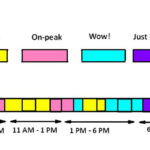Leland Teschler • Executive editor
Officials estimate it will cost $50 billion to field the chargers needed for the expected number of electric vehicles on U.S. roads by 2030. But it’s possible that spending every penny of this amount won’t prevent the extinction of the cross-country road trip.
Here’s the logic behind that statement: It’s easy to find stories on the internet of people driving 3,000 miles from New York to Los Angeles in about three to five days. Those taking five days average about 600 miles a day and spend 10 to 12 hours behind the wheel at a stretch, gas stops included.
driving 3,000 miles from New York to Los Angeles in about three to five days. Those taking five days average about 600 miles a day and spend 10 to 12 hours behind the wheel at a stretch, gas stops included.
Now consider that experience in an electric vehicle. Right now, the EV with the longest range is a version of the 2021 Tesla Model S, coming in at 387 miles. When out of juice, it pulls up to a V3 Tesla Supercharger and is at 100% charge about an hour later.
Of course, the one-hour recharge time assumes there’s no one else in line. That may be a bad assumption when most cars on the road are EVs. Unlike gas pumps where the experience of three cars in line ahead of you is just annoying, three EVs ahead of you at a charger kills the afternoon. That wait time may be OK for EV owners who can work in their office or sit at home while their car recharges. It is not OK for drivers cooling their heels at a turnpike rest stop. So much for covering 600 miles in a day. Those making a cross-country trip in this Tesla could easily end up spending half their travel time waiting in charger queues.
Some pundits claim EVs in 2030 will be getting 600 miles per charge, but that’s speculative. Even if such ranges are available, they’ll likely be confined to high-end vehicles. Most EVs on the road in 2030 are more likely to have ranges closer to today’s Tesla Model S.
And charge time isn’t likely to be the only logistical issue discouraging road trips. A turnpike rest stop today might have two dozen gas pumps. That’s fine when refueling takes five minutes but not when it takes an hour. It is not unreasonable to expect rest stops to host double or triple that number of recharging stations. But on that scale, grid capacity may become problematic.
Consider that top-end chargers today operate at 600 V and 50 A when going full blast. That means 30 of them sitting at a turnpike rest stop would draw close to a megawatt at full capacity. That amount is equivalent to the peak load of a U.S. suburb. So it’s possible the average rest stop won’t be able to power all its EV chargers during times of peak grid load.
Now suppose an acre of PV panels surrounding the rest stop helps handle the load. An acre of solar panels provides an average of 1 MWh per day. Back-of-the-envelope calculations show a solar installation that size can simultaneously power only about five superchargers, but only when the sun shines.
These factors combined make a long road trip in an EV look more like a nightmare than an adventure. Perhaps trips in hydrogen-powered fuel-cell vehicles will be more attractive. Hydrogen FCVs have their own logistical issues, but refueling time isn’t one of them. All in all, it’s easy to conclude that vehicles powered by internal combustion engines may be here a bit longer than pundits predict.







You’ve never taken a road trip in a Tesla, have you? You usually don’t actually wait around an hour for a 100% charge — it’s at 80% in 20 minutes.
How much do you think it cost to build the ~150,000 gas stations in the US? At $500K per station, that’s $75B, so $50B for recharging stations isn’t outrageous, and if charging stations are getting significant use, they’ll generate significant cashflow to expand.
Also, don’t pin your hopes on hydrogen. I drove a natural gas powered car for a decade, and the high pressure compressor stations are slow and more expensive than gas stations. Natural gas tanks run at 3,600 psi, while hydrogen needs to be roughly twice that pressure for the same energy density. This makes the tanks in your car heavy, expensive, low capacity, and life-limited. Pop Quiz: How many hydrogen stations are there in the US?
Answer: 47, all but three in California.
Electric cars should really be called Coal Powered vehicles because even in 2030 wind and solar will not be able to come close to supplying our energy needs. Especially with the added demand that Electric cars will require.